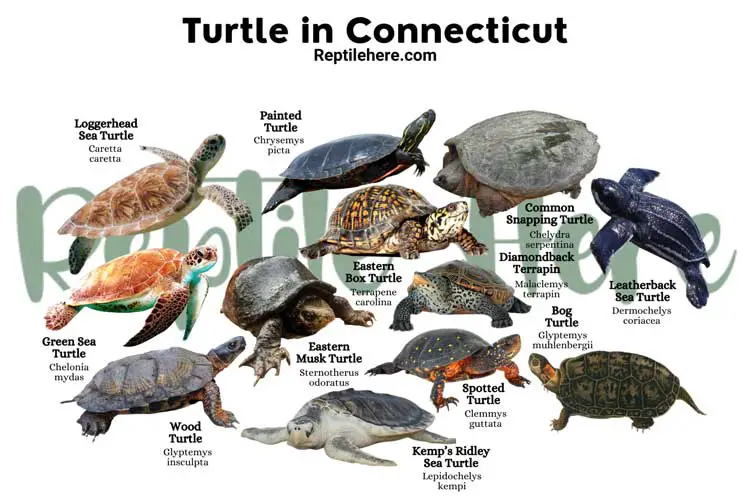Turtle in Connecticut -12 Species That are Found Here
Connecticut is home to 12 species of turtles. These are all native species and include sea turtles, freshwater turtles, and terrestrial turtles.
Some of these turtles of Connecticut are labeled as endangered or critically endangered and it is illegal to own or sell them. Or you’re limited on how many specimens you can own.
The following article will get into more details about all the 12 species to help you better understand the unique attributes of each of them.
We will focus on the basics of each species such as physical appearance, average adult size, what they eat, where they live, and conservation status.
12 Types Of Turtles In Connecticut
Contents
1. Common Snapping Turtle
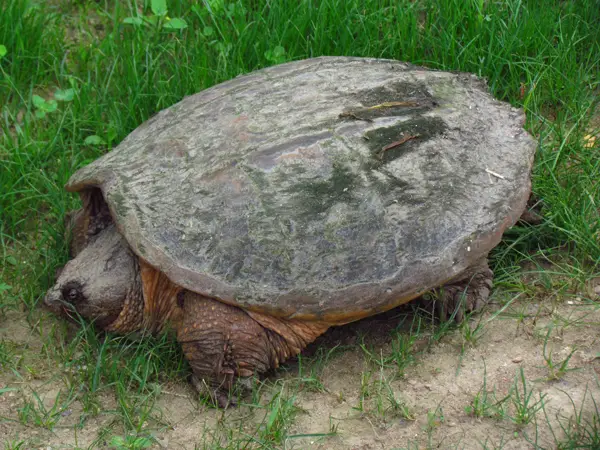
- Scientific name: Chelydra serpentina
- Common name: Snapping Turtle
- Family: Chelydridae
- Size: 8 to 18 1/2 inches
- Lifespan: 30 to 50 years or more
- Conservation status: Least Concern
Common snapping turtles are widespread throughout Connecticut. An average adult is pretty large and has a shell length of 18½ inches long.
This species has a chunky head, a long tail, and large webbed feet. The shell color is black or olive and has no distinct pattern. These Connecticut snapping turtles are known for their powerful jaws—they’re so strong that these turtles eat other turtles!
You’ll find them in waterbodies with muddy bottoms. Examples include marshes, ponds, lakes, rivers, and even shallow streams. They generally prefer waters with aquatic vegetation in plenty and foods such as fish, frogs, birds, etc.
These Connecticut turtles generally show docile behavior but can get quite aggressive if taken out of water. The best way to calm it is to take it back to the waters, where it feels safe.
2. Painted Turtle
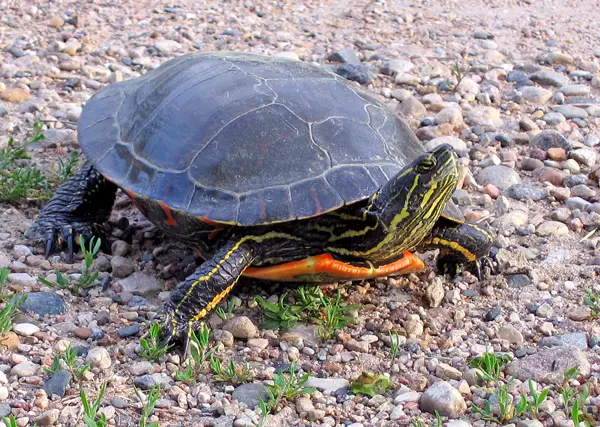
- Scientific name: Chrysemys picta
- Common name: Painted Turtle
- Family: Emydidae
- Size: 4 to 6 inches
- Lifespan: 30 to 50 years
- Conservation status: Least Concern
The Eastern painted turtle is one of the most recognizable turtle species in Connecticut, thanks to its beautiful and unique coloring. The bright reds and yellow-green markings on its shell, head, and limbs are no doubt a beauty to behold!
This painted turtle sub-species in Connecticut has been observed to live near water bodies with minimal movements. Examples include marshes, ponds, slow-moving streams with sandy/muddy bottoms, small lakes, etc.
They also prefer areas with aquatic plants in plenty as they make their primary food source in the wild.
One interesting fact about these Connecticut turtles is their ability to hold their breath for up to 30 hours when inside temperate water. Moreover, they’re capable of standing dominant in freezing cold waters for up to 4 months.
Unfortunately, it’s not easy to establish the population of these turtles in Connecticut. This is because most people who pet them end up releasing them back into the wild. This contributes to an ever-expanding range plus unstable reproduction rates for these turtles.
3. Diamondback Terrapin
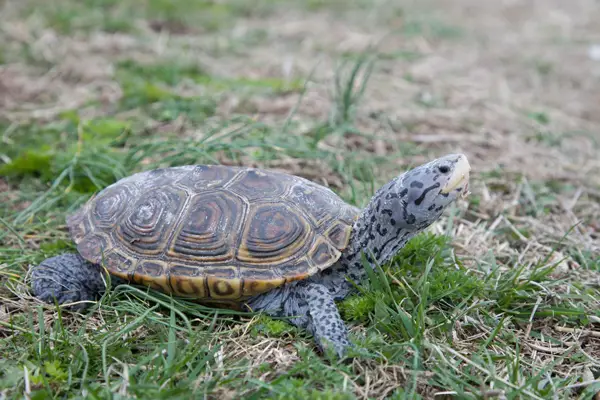
- Scientific name: Malaclemys terrapin
- Common name: Diamondback Terrapin
- Family: Emydidae
- Size: 4 to 6 inches (males), 5 to 8 inches (females)
- Lifespan: 25 to 35 years
- Conservation status: Vulnerable
The Mississippi diamondback terrapin is the only freshwater species in Connecticut that can adapt to saltwater as well. Their shells have a raised diamond shape, hence the name diamondback. The term “terrapin” simply means little turtle.
A typical diamondback terrapin in Connecticut has black or brown carapace and yellow lower shell that may sometimes feature dark-colored patterns. The turtle’s skin is usually grey-white with multiple small black spots.
Female diamondback terrapins are usually bigger than their male counterparts.
These turtles are highly timid and can easily get stressed when in captivity. They’re pretty docile and can be handled. However, they’re known to bite as a way of defending themselves if they feel threatened.
Diamondback terrapins can be found along the coast in tidal flats, salt marshes, barrier beaches, and brackish streams in Connecticut. They can also stay in full-strength saltwater for longer periods.
The terrapins are largely carnivorous and feed on crustaceans, fish, crabs, shrimps, marine snails, marine worms, mollusks, mussels, clams, and barnacles. However, they also tend to occasionally ingest small amounts of plant matter.
4. Eastern Musk Turtle
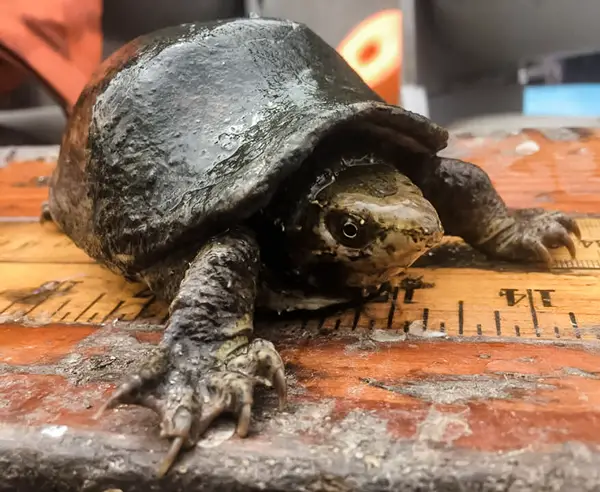
- Scientific name: Sternotherus odoratus
- Common name: Eastern Musk Turtle, Common Musk Turtle, Musk Turtle, Stinkpot
- Family: Kinosternidae
- Size: 2 to 4.5 inches
- Lifespan: 30 to 50 years
- Conservation status: Least Concern
The Eastern Musk Turtle is another aquatic turtle found in Connecticut’s slow-moving and sluggish streams as well as still water bodies. The turtle usually prefers areas with dark crevices, where it can easily hide. It also prefers lots of plant matter to burrow in and hide.
An average adult eastern musk turtle is quite small (2 to 4.5 inches long). It has a pretty plain appearance with highly consistent colors. Both the shell and skin usually share the same color and can range from dark brown to black.
The turtle shell has one unique feature—a ridge traversing its entire shell length. Besides, it has another distinctive feature: two light-colored stripes on its head.
Common musk turtles of Connecticut are herbivorous and will eat small aquatic or semi-aquatic animals, carrion, and aquatic vegetation. They will also feed on any other vegetation on land.
When it feels threatened, this turtle species emits a foul odor (a musky odor, hence its name). This scent can be detected in water or on land. It can also easily waft through the air to its predators.
Also, these Connecticut turtles are good at climbing trees! This great capability enables them to go high up tree branches to find a safe resting place and avoid predators.
5. Spotted Turtle
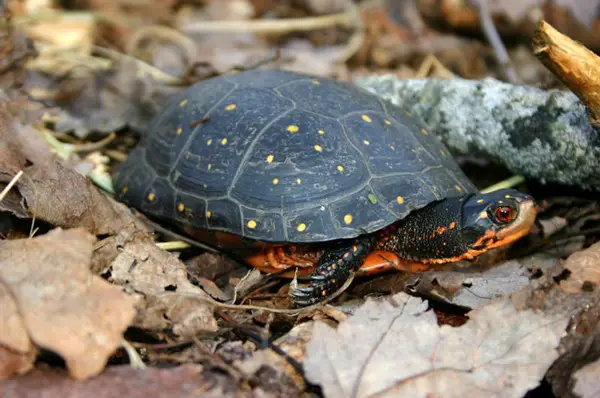
- Scientific name: Clemmys guttata
- Common name: Spotted Turtle
- Family: Emydidae
- Size: 4 to 5 inches
- Lifespan: 25 to 50 years
- Conservation status: Endangered
Spotted turtles in Connecticut reside in shallow marshes, swamps, and bogs. They’re semi-aquatic and are comfortable on the land just as they are in the waters.
An adult spotted turtle has a smooth upper shell that ranges from olive to dark brown in color, with some light yellow spots. The neck and head feature irregular orange or yellow spots and streaks. Also, their tails are fairly long.
The turtles are omnivorous and their diet involves crustaceans, mollusks, insects, and plant matter (occasionally). Note that these turtles are aggressive hunters and will actively seek their prey.
Unfortunately, the population of spotted turtles in Connecticut is on the decline due to human interference and habitat loss. Their unique shell patterns make them a favorite species of a pet turtle for many people.
For this reason, they’re listed as endangered and protected by many governing bodies. In Connecticut state, you can only own ONE spotted turtle and not more than that!
Above all, the spotted turtles of Connecticut are incredibly smart. Studies carried on them using a maze indicate they have the same brain capacity as the mouse!
Also read: Turtles in Nebraska
6. Bog Turtle
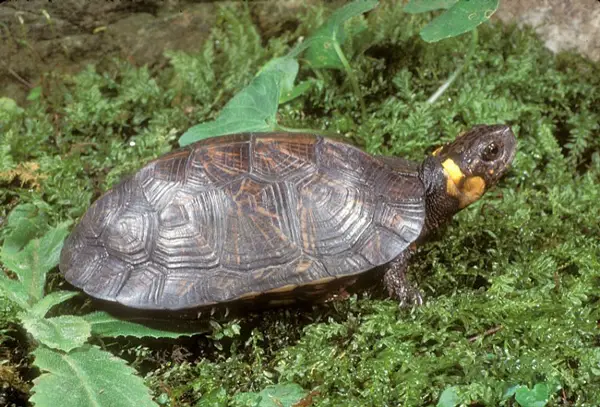
- Scientific name: Glyptemys muhlenbergii
- Common name: Bog Turtle, Muhlenberg’s turtle
- Family: Emydidae
- Size: 3.5 to 5 inches
- Lifespan: up to 40 years
- Conservation status: Critically Endangered
The Bog turtle is the smallest aquatic turtle you’ll find in Connecticut and North America in general.
The species is critically endangered and is one of the rarest turtles in the state; it is only seen in the western counties of Connecticut.
Mind you; selling or owning a bog turtle in Connecticut is illegal!
An adult bog turtle’s carapace coloration ranges from black to olive or dark brown and features a central keel ridge. Some of the scutes making up their upper shell may also bear red or yellow-star markings. And their heads have distinctive orange or yellow patches.
The bog turtle is known to inhabit wetland areas such as marshes or bogs populated with grass cover.
These turtle species are diurnal omnivores and like eating insects, mollusks, and occasional vegetation. They’re most active during warm parts of the day.
7. Wood Turtle
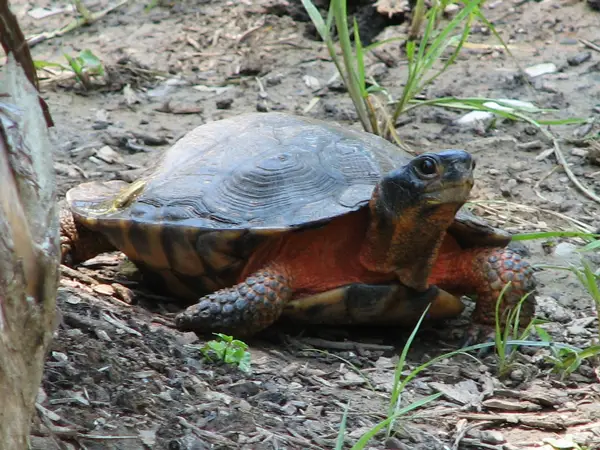
- Scientific name: Glyptemys insculpta
- Common name: Wood turtle, Sculptured Tortoise, Redleg, Red-legged Tortoise
- Family: Emydidae
- Size: 5.5 to 8 inches
- Lifespan: 40 to 60 years
- Conservation status: Endangered
Wood turtle species also inhabit the various woodland habitats across Connecticut state. However, they also tend to stay near the water and will frequently venture into it.
During winter, they tend to hibernate at the bottom of deep rivers and pools.
The turtles get their name from their sculpted-like looks. Their upper shells are dark brown and have sport patterns resembling wood grain and growth rings.
Their scutes may sometimes appear like they’re pyramiding, further enhancing their sculpted shape.
Wood turtles of Connecticut are diurnal omnivores and their diet mainly consists of berries, plants, insects, and mollusks.
They forage for their food widely and have even been observed stomping their feet on the ground as a way of tricking the earthworms into surfacing.
8. Eastern Box Turtle
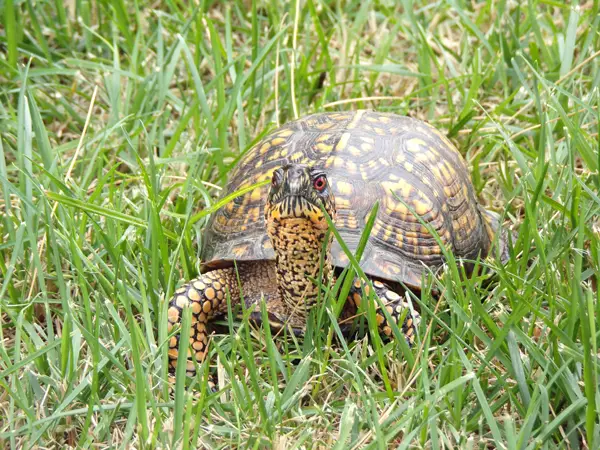
- Scientific name: Terrapene carolina
- Common name: Eastern Box Turtle, Land turtle, Box Turtle
- Family: Emydidae
- Size: 4.5 and 7 inches
- Lifespan: 50 to 100 years
- Conservation status: Vulnerable
The eastern box turtles are also present in Connecticut. They prefer these areas due to abundant access to sunlight and food sources nearby.
An adult turtle of this species is about 4.5 to 7 inches and weighs just 2lbs. It has a high, domed shell shape with a ridge running from head to toe. The shell of this turtle has varying colors of olive, brown, and tan.
The variation in markings on the shells of these turtles is so variable that you can’t easily recognize one by looking at the shell alone.
These eastern box turtles of Connecticut are omnivorous and feed on a variety of foods including insects, meat, fruits, vegetables, and various types of vegetation.
Note that eastern box turtles are taken from the Connecticut wild for pet trade, leading to a decline in their population. For this reason, many states have illegalized capturing and selling of this species.
And those in captivity end up dying due to poor conditions or being abandoned or released back into the wild because they’re too demanding to maintain.
9. Leatherback Sea Turtle
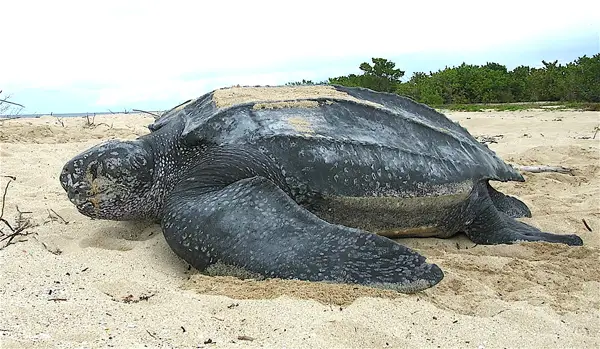
- Scientific name: Dermochelys coriacea
- Common name: leathery turtle, trunk turtle, Lute turtle, luth
- Family: Dermochelyidae
- Size: 5 to 6 feet
- Lifespan: 50+ years
- Conservation status: Vulnerable
The leatherback sea turtles are also found in Connecticut state and are known to grow to mammoth sizes (up to 6 feet!). An average adult can also weigh as heavy as 540lbs!
Leatherback turtles usually have black shells. And they differ from other species of turtles with their smooth leathery carapace and skin. Their upper shell is made up of a flexible layer of dermal bones covered by tough and oily connective tissue and smooth skin.
The body of this turtle is barrel-shaped and then tapered to the rear. They have a total of 7 longitudinal dorsal ridges and their whole body is almost completely black, with some variable spotting.
Leatherback turtles in Connecticut have tooth-like cusps that work closely with their sharp-edged jaws to enable them to easily feed on jellyfish, salps, and other gelatinous zooplankton.
As for the habitat, these turtles of Connecticut are fond of tropical and subtropical waters all year round. But they tend to migrate to cooler, temperate, and boreal waters during warm weather.
Note that this species is highly migratory and can swim as many as 10,000 miles in a year between foraging and nesting grounds. They’re also excellent divers—with the deepest diving record standing at whopping 4,000 feet!
10. Green Sea Turtle
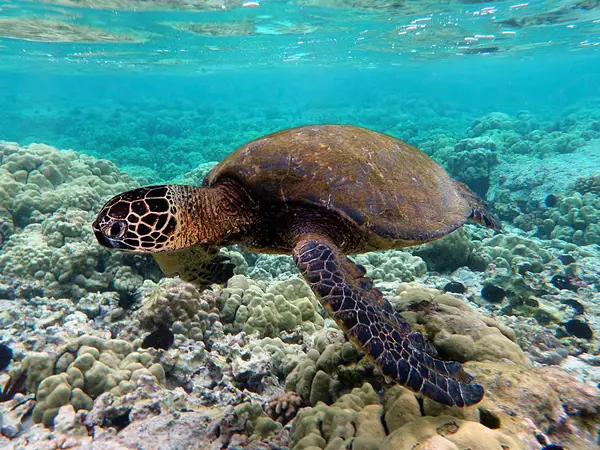
- Scientific name: Chelonia mydas
- Common name: Green turtle, Pacific green turtle, Black sea turtle
- Family: Cheloniidae
- Size: 2 to 5 feet
- Lifespan: 60 to 70 years
- Conservation status: Endangered
The green sea turtle species is classified among the largest hard-shelled sea turtles in Connecticut. It can reach up to 4 feet in length and weighs up to 400lbs.
This species is characterized by scutes that run down the middle; they’re 4 on each side. The shell color can be gray, dark brown, or olive with a yellow-to-white bottom shell or plastron.
It also features a serrated beak on its lower jaw and two large scales resign between the eyes.
Males are generally larger than females and have longer tails. The females lay their eggs on the beach and use their paddle-shaped flippers to easily burrow in the sand when laying eggs. A single green turtle can lay up to 200 eggs!
This sea turtle species in Connecticut gets its name from its primary diet which consists of age and seagrasses (mind you, this diet is responsible for tinting its cartilage green).
Green turtles in Connecticut are usually found in tropical as well as subtropical waters throughout the years. They also tend to migrate to cooler temperatures and even boreal waters when the weather gets warmer.
11. Loggerhead Sea Turtle
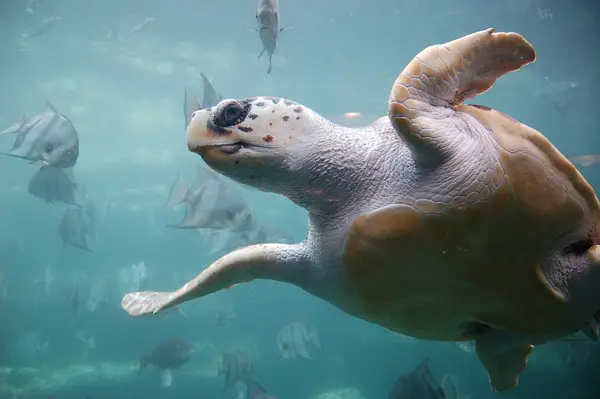
- Scientific name: Caretta caretta
- Common name: Loggerhead, Loggerhead Sea-Turtle
- Family: Cheloniidae
- Size: 3.5 feet
- Lifespan: 70+ years
- Conservation status: Endangered
Loggerhead sea turtles boast their place as the most abundant sea turtle species in the United States and are found in many states, including Connecticut.
These turtles are pretty big and can reach up to 3.5ft in length. They weigh up to 350 pounds and can live for a whopping 70 years or more.
A loggerhead is distinguished by a slightly heart-shaped carapace that’s reddish brown in color, with pale yellow plastron. Some species also feature yellow-bordered scutes.
This turtle species of Connecticut gets its name from its large head. It has powerful jaws that enable it to feed on a variety of foods including conch, whelks, insects, jellyfish, gastropods, and algae.
The loggerhead turtles in Connecticut are usually found in temperate, tropical, and subtropical waters all year round. However, they also tend to migrate to cold boreal waters on rare occasions.
12. Kemp’s Ridley Sea Turtle
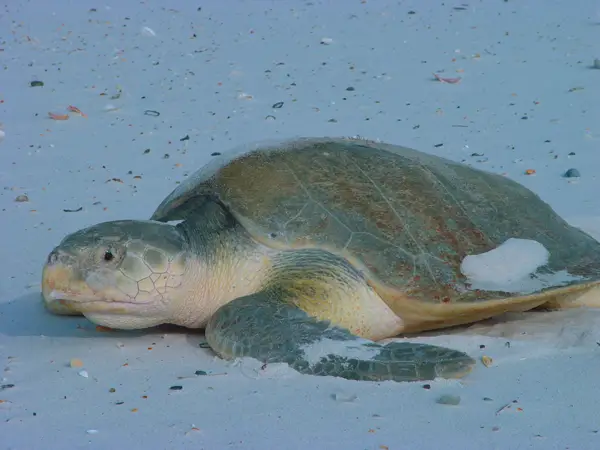
- Scientific name: Lepidochelys kempi
- Common name: Atlantic ridley sea turtle,
- Family: Cheloniidae
- Size: 2+ feet
- Lifespan: 30+ years
- Conservation status: Critically endangered
Kemp’s ridley sea turtle is the smallest species of all the sea turtles in Connecticut. The average adult size is about 2 feet and weighs approx. 110 lbs. They have adapted flippers (front limbs) and a beak.
This turtle is the rarest sea turtle species and is one of the world’s most endangered species. The species is called Kemp’s ridley because Richard Moore Kemp of Key West was the first to send its specimen to Samuel Garman at Harvard university. However, the origin of the name ridley is still unclear.
Note that these turtles tend to change their color as they age. Baby turtles feature dark purple color along the sides which turns into yellow-green as they mature.
Kemp Ridley is also the only sea turtle that nests during the day.
These Connecticut turtles also practice Arribada nesting, which involves all the females nesting together in a tight group. This helps them protect themselves better from predators as well as help their hatchlings easily make it to the open ocean.
Related: Turtles in Oklahoma
Conclusion
These are the 12 species of turtles native to Connecticut. As you have seen from the above list, these species include freshwater, sea, and land turtles.
Some of the species like the wood and spotted turtles are endangered species and under protection by the state authorities.
Now you know the various species that inhabit the state of Connecticut and the basic information about each of them to help you easily identify them.


